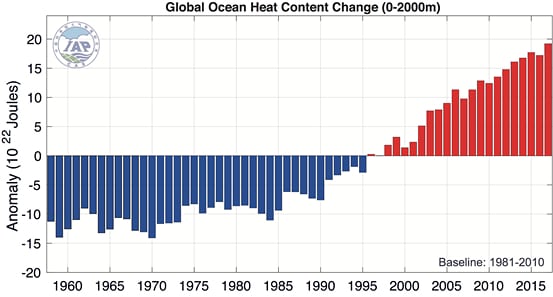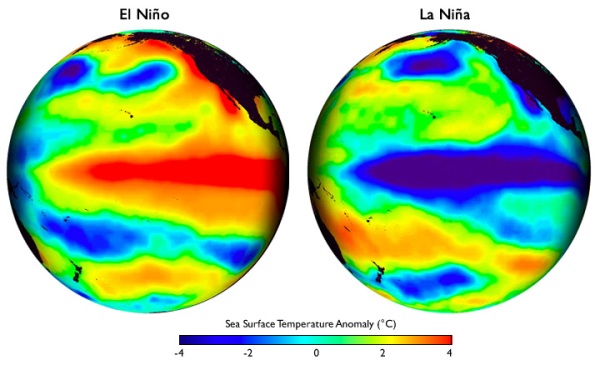Not Even the Briefest of Pauses for Human-Forced Global Warming — Oceans During 2017 Were the Hottest on Record
26
January, 2018
Where
does most of the heat trapped by human fossil fuel and other
greenhouse gas emissions ultimately end up? Given our fixation
on global surface temperatures, many people would say ‘the
atmosphere.’ But this answer is incorrect. The vast majority ends
up in the world ocean.
The
world ocean system is the largest heat sink on our planet’s
surface. This is due to the fact that liquid water contained in the
oceans both has a far greater mass and overall heat
capacity than
the atmosphere. Just a fraction — less than 1/30th of the heat
trapped by human-emitted greenhouse gasses ends up in the atmosphere.
Similar portions end up getting soaked in by the land and by melting
glaciers. The rest, about
90 percent,
finds its way into the oceans.
The
ocean is thus the best, most reliable global thermometer available.
For good reason, most scientists wait for readings from this big, wet
thermostat to get an idea where global temperatures are headed and
how fast. And what some of the world’s top ocean researchers found
this week was that during 2017 the
top 6,000 feet of the world’s oceans experienced their hottest year
ever recorded.
(Ocean
heat content change since 1958. Illustration: Cheng and Zhu
(2018), Advances
in Atmospheric Sciences.)
Not
only was 2017 the hottest ocean year on record, the heat gain from
the previous hottest ocean year (2015) was quite considerable. In
all 15,100,000,000,000,000,000,000
Joules of heat energy were added by the world ocean from 2015 to
2017.
By comparison, 4,184,000,000 Joules were produced by the Hiroshima
bomb. The world ocean is now taking in a similar amount of heat every
3-5 seconds.
In
the atmosphere, we tend to focus on El Nino years as the hot ones in
an ongoing upward trend.
This is because warm surface waters spreading across the Equatorial
Pacific belch a bit of that huge volume of stored ocean heat back
into the atmosphere. But during La Nina years, cooler surface waters
across wide regions of the Equator swallow up more of the atmospheric
heat. It is during these years that oceans tend to warm the most
swiftly even as atmospheric warming tends to take a break. 2017 saw a
weak La Nina and a comparatively strong rate of related ocean heat
gain. And though atmospheric
temperatures were ‘only’ the second hottest ever recorded
according to NASA,
ocean temperatures tracked further into uncharted territory.
(During
El Nino years [left], the global oceans transfer a portion of their
vast store of warmth to the atmosphere. During La Nina years [right]
the oceans draw in more of the atmosphere’s heat. Image
source: Climate.gov.)
It’s
worth noting that ocean heat gain is presently both quite rapid and
rather steady. All
of the past five years were each one of the five hottest ocean years
ever recorded.
Global temperature gain thus hasn’t slowed. And though atmospheric
temperature gain has accelerated during recent years, the ocean
measure hints that overall heat gain per year has been pretty steady
since the mid 1990s. At least for the top 6,000 feet of the world’s
surface waters (though other measures provide some hints at
acceleration [see image at top of this post]). An observation that
would seem to reinforce the present decadal rate of temperature
increase in the range of 0.15 to 0.20 C every ten years or about 30
to 50 times faster than the warming that ended the last ice age.
To
be clear, the primary driver of what is a very rapid warming in the
geological context is human fossil fuel burning and related carbon
emissions in the range of 11 billion tons per year. Halting fossil
fuel burning is therefore critical to slowing down and ultimately
stopping the present rate of warming and dangerous related
atmospheric and ocean carbon addition.






No comments:
Post a Comment
Note: only a member of this blog may post a comment.